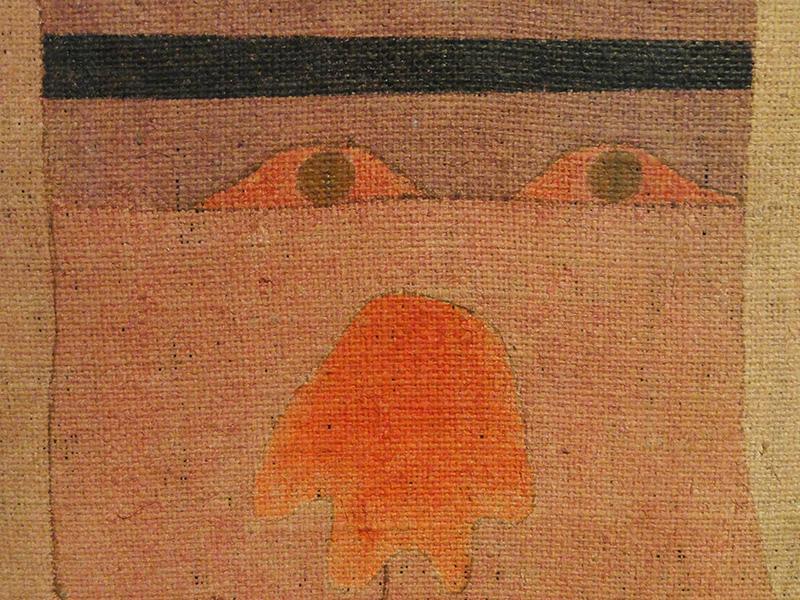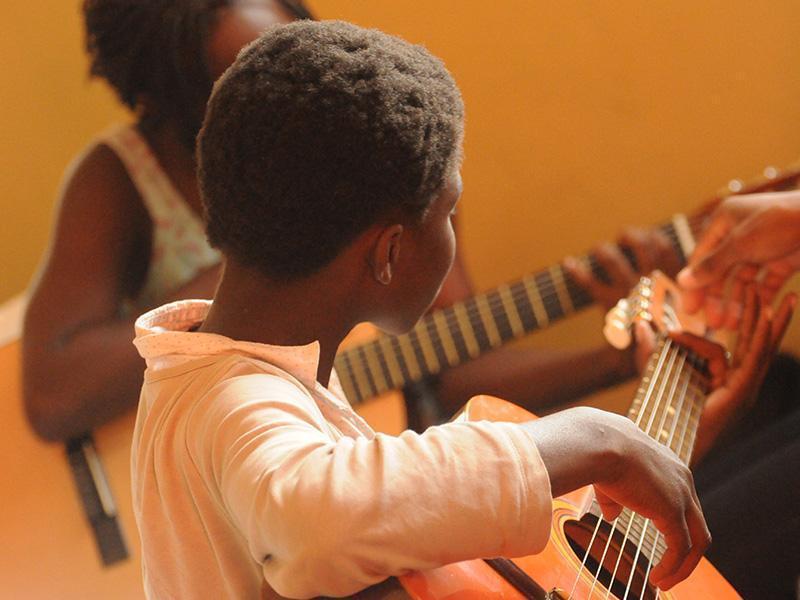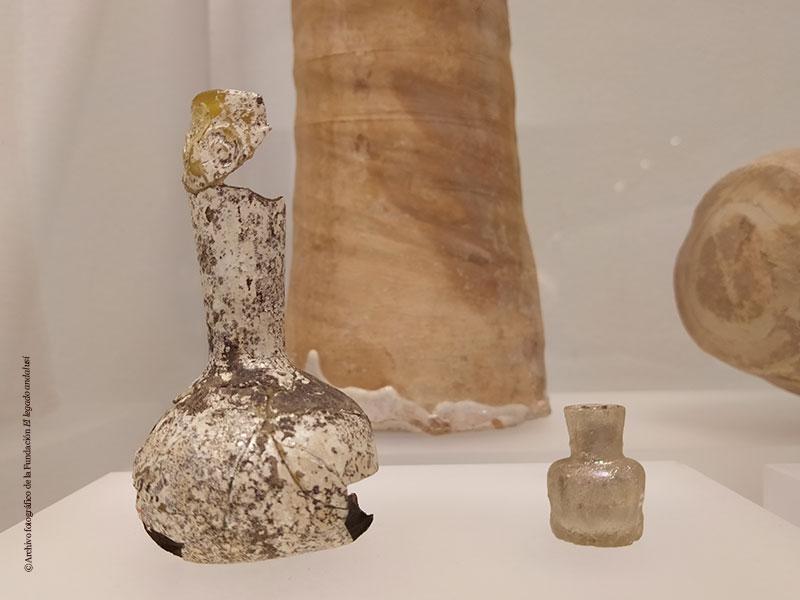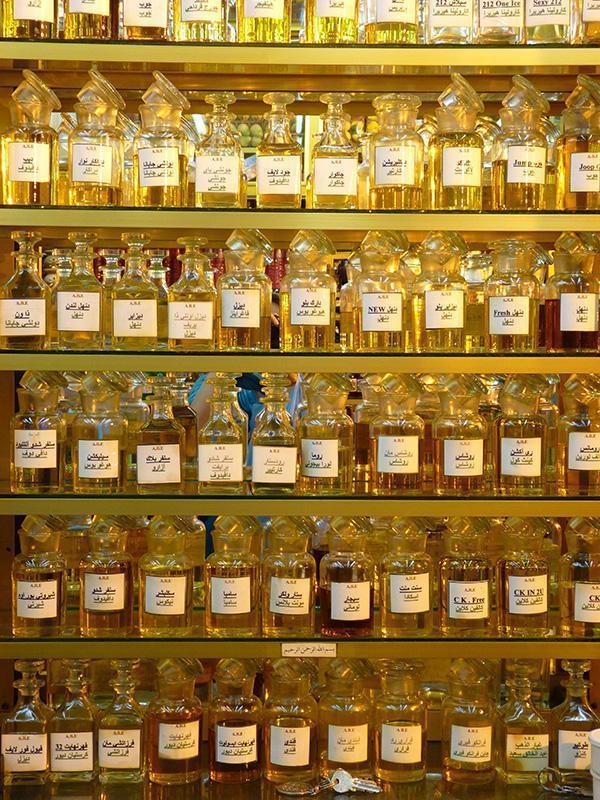
Ziryab,
the amazing story of the singer from Baghdad
The importance of the figure of Ziryab in the court of the Cordoban Umayyad king Abd-er-Rahman II is credited for the innovations he introduced in the court and Cordoban society in several fields. He was surely one of the most prolific artists of all time.
Who, in these times, has not run out to relax at a spa to unwind and feel better, or has decided to follow the tenets of fashion, or relished the most delicious of Oriental cuisine? And surely when we talk of Abul-Hasan Ali ben Nafi, hardly anyone knows to whom we are referring and that all we have just mentioned are things that were already in practice in the 9th century. And, if we say that our person was known as Ziryab, given that the dark colour of his skin reminded of a bird with dark plumage from the region of Baghdad, it is quite probable that a lot of people do know who he is.
Ziryab was actually like a breath of fresh air that entered the court of the newcomer Abd-er-Rahman II. Crowned king very young, he trusted Ziryab for being equally young. This may be why Ziryab shone so exceedingly in that court, being remembered over the centuries as one of the greatest musicians and the advocate of good taste, for he influenced the manners of his time, gastronomy and also fashion.
Ziryab’s life was not a path strewn with roses; he had to overcome many difficulties before achieving the plenitude of his fame. He was born in Baghdad in the year 789, and since his earliest years he distinguished himself as a gifted student of the famous musician and singer of the Baghdad court, Isqaq al-Mawsili. It was he who took Ziryab before the caliph, as he was one of his best students, and this set off a series of unparalleled circumstances.
According to chronicles written at that time, when Ziryab had the caliph Harun al-Rashid in front of him, he surpassed himself. But most curious was that when Ziryab’s master al-Mawsili gave the young musician his own instrument, Ziryab rejected it, to the astonishment of the caliph and the master al-Mawsili. The reasons were none other than Ziryab’s own opinion that in order to allow the caliph to enjoy his music, it should be conveyed through his own instrument. But this did not stop there, as Ziryab also explained to the caliph that his lute was unlike any other, for he himself had made some arrangements to make it sound better. Among these arrangements, he had added a fifth string, had made the lute’s neck longer and the instrument a bit lighter. As Ziryab started to sing, everybody was amazed, among them the very caliph, who did not hesitate in asking for an encore, and he did over and over.
This event was to be later a bitter landmark in Ziryab’s life, since his master al-Mawsili was seized by jealousy, confessing to the young musician that he might lose his reputation as a court singer due to the new music that had captured the caliph’s senses. And for this reason, he had no other choice than proposing him two options: one of them was that Ziryab should leave Baghdad and settle down in faraway lands where his name could never reach the ears of the caliph. The other was that he could stay in the city, although without his protection, and having him as an enemy to be feared, for he would undermine his music through his influence. In this way, Ziryab decided to leave his beloved Baghdad, which he never forgot, as he took along his city wherever he went.
Detail of the work “Arab Song” by Paul Klee.

From that moment on, his life was a great adventure that had its good and bad moments. His long wanderings through the lands of various deserts put him in touch with people from diverse latitudes who enriched him both in personal ways and in musical terms through the ancient chants that touched his soul, enabling him to transmit them in his music and in the ways he performed, in a more and more personalized style. This new life took him to the lands of Egypt and Palestine, where he survived carrying out all the teachings he had learnt from his master, as well as developing a new repertoire that he demonstrated everywhere he went. Ziryab experienced poverty, but despite this, he never gave up. This prompted him to travel to Kairouan, as he thought that he might be more fortunate in the court of the Aghlabid sultan Ziyadat Allah I. From Kairouan, he heard news coming from al-Andalus telling about the way that prosperous land had moved forward culturally. At the same time, the merchants from Kairouan travelled, disseminating the news of the young musician and his great virtuosity.
Despite being well known in Kairouan, the incomes he received for his performances was low. Hence, in a moment of hope and inspiration, he decided to write to the emir of Córdoba, al-Hakam I, to offer his services. That letter was entrusted to a merchant and forgot it, as he thought that the emir would not take into account a musician from such faraway lands. However, he received an answer from al-Hakam I because he had heard of Ziryab through a musician who was in his service, the Jew Abul-Nasr-Mansur, who spoke of him grandly. This changed Ziryab’s life dramatically, for the emir offered him terms that would have been unimaginable for him only a few days earlier. From here Ziryab left to the Iberian Peninsula filled with hope. When he disembarked in Algeciras in the year 822, being 33 years old, he was surprised by the news that Abul-Nasr-Mansur himself shared with him: the emir al-Hakam I had passed away. Ziryab’s dreams were dashed once again, and he even thought about going back to Africa. However, the successor, Abd-er-Rahman II, son of al-Hakam I, maintained in force the contract that his father had signed with the young musician, who was showered with important gifts. Ziryab was taken to Córdoba, where he was treated like a king and stayed in the court three days to rest before meeting the monarch.
The encounter between Ziryab and the young king was very gratifying, as Abd-er-Rahman II appreciated the many qualities of Ziryab, who in the same way felt himself recognised by the emir. Both young men connected immediately, and Abd-er-Rahman did not hesitate to offer the musician an amount of 200 dinars per month, as well as some prosperous lands in Córdoba. He settled in the Almunia (farm) Munyat Nasr, built by Fata Nasr, a member of Abd-er-Rahman II’s family and his man of confidence. In the end, Ziryab acquired great prestige and used his varied talents in many different fields such as music, gastronomy, fashion and manners.
Music was very important in Córdoba during the 9th century, due in part to this figure who, apart of establishing the first conservatory of al-Andalus music, encouraged his sons, who were all musicians, to be the main source to disseminate this music. Among his male sons, the ones who stood out most were Obaidala, who was the best singer, followed by Abd-er-Rahman, Qasim and Mohammed. Regarding his daughters, the most outstanding was Alia. She was wildly in demand as a singing teacher, and she continued the legacy of her father’s tradition. But not only his sons were the main disseminators of his music; the court’s slaves also did, the most outstanding being Metta and Masabih, slaves to Abd-er Rahman II and the secretary Omar ben Kalil.
To all that we must add his great qualities as a pedagogue, and according to historian Ibn Hayyan: “It is still in practice in Spain that any learning voice beginner starts by annexing recitations as first exercise, accompanied by any type of percussion right after the simple chanting or plain chant, following the instruction to get in the end with more lively music to the more complex pieces, like the hezeches, according to the teachings methods introduced by Ziryab”.
Ziryab’s contribution was very important as it ended somehow with the improvisation as much of the rhythm as the mode that was recurring at the time of performing the Arab chants of al-Andalus, hence setting up a series of premises that would enhance the recognition of this art.
As Martín Moreno point outs: “Ziryab was the first composer of the Arab chants known as moaxaja. The first rules established for chant succession nowadays is known in Turkey as faacel, in the eastern world as ovasla and in North Africa as nuba”.
At the same time, we must talk about the important innovations in the field of instrumentation. We find the best example in his own lute, which, according to some sources from his time, weighed one-third less than the conventional lutes. Strings were made out of a type of silk which was not spun with hot water, for that might make them weaker. The bass and third strings were made of the intestine of a new-born lion, and for this reason their sound had more sweetness, it was cleaner and had more sonority than those made with the intestines of other animals. Strings made with lion’s intestines were stronger, and they could better withstand the plucking of the plectrum. And above everything, the most important element was the addition of a fifth string
“The traditional lute had four strings which, according to the theoreticians’ symbolism, corresponded to the four humours of the human body: the first one was the yellow, and symbolized bile; the second, red, symbolized blood; the third, white, with no colour, symbolized phlegm, while the bass string, dyed in black, symbolized melancholy. The fifth string added by Ziryab symbolized soul. It was also dyed in red and placed in the centre, between the second and the third strings, increasing the expressive possibilities of the instrument”. (Historia de la Música de Andalucía . Martín Moreno, p. 42).

Gastronomy was a great contribution from Ziryab, strongly supported by Abd-er-Rahman II, who, like a good Umayyad, felt a great admiration for everything coming from Baghdad.
This prompted Ziryab to transmit all his knowledge of the most complicated dishes from the Baghdad’s cuisine. He also showed the way of setting a table and the order in which to serve food, as feasts normally started in al-Andalus “serving every plate at a time, still steaming hot, on a low table. Forks and knives were absent, although wooden spoons were provided for soups, which were served in faience bowls. Cold appetizers were served, consisting in salted and marinated fish, followed by chicken or lamb dishes boiled over low fire, poultry and game-meat pies, and a dish known in al-Andalus as tafaya (Oriental-style stews made of meat, chicken or marinated fish), pancakes with chicken meatballs, or puff pastries filled with minced sausage or pigeon meat, mixed with almond paste, or toasted semolina diluted in honey”. All this mishmash of dishes allowed Ziryab to show the people of al-Andalus how was “the order of serving in an elegant table, avoiding serving the delicacies mixed, but starting with soups and following with meat and starters of poultry, strongly seasoned, to end with sweet dishes like nuts cakes, almonds with honey, or vanilla scented pastries, filled with pistachio and hazelnut”. However, beyond these delicacies, according to Ziryab, it was in bad taste to set them on fabric tablecloths. In this way he proposed using a tablecloth made with very fine leather, like those that had been used for some time in his beloved Baghdad. This led to a boom of this art of leatherworking in Córdoba which was to continue over the course of centuries. In the second half of the 10th century, the monk Heraclius explained: ‘Quomodi corduanum turgituri’, as a compliment to the skills of the Spanish people in leatherworking. Yet, no remains of the praised quality of the Cordoban tablecloths are known.

Unguent glass jars. Madinat Ilbira. Granada. 9th-10th centuries. Archaeological and Ethnographic Museum of Granada.
The use of essential oils, unguents and balms were very popular in the times of Ziryab in al-Andalus, as well as in the rest of the Muslim world, and its use was paramount in the beauty treatments used in the hammam.
An let’s say that, as if to put the cherry on top of the cake, Ziryab suggested to Abd-er-Rahman II that it was advisable to drink wine in crystal glasses, for wine taste did not deserve to be sipped from metal; hence an industry emerged from that moment on, thanks to the advances in the field of glass introduced by Abbas ibn Firnas. Actually, some pieces have been found in Madinat al-Zahra which show how important the use of glass was.
According to Ziryab, wine served in a crystal glass woke all of the five senses, since it could be savoured through the sense taste; the wine color, thanks to the transparency of the glass, through the sense of sight; when smelling it, the sense of smell; and the touch was in the very shape of the glass, by the thinner part; and lastly, with the sense of hearing, when clinking glasses for a toast.
But Ziryab not only exerted his influence in the above-mentioned fields; we also owe to him a lot in reference to good taste in clothing and good manners. Fashion in those times was quite boring. Men and women from al-Andalus used in general the same fabrics, and they even shared the same type of apparel, for they both wore as underwear a sort of a long shirt named qamis and long and tight trousers named zaragüelles that were adjusted to the waist by a cord.
On the qamis they wore a bodice made of very thin fabric named qilala. In winter, both women and men added to all that a sort of a thicker tunic or a rabbit or sheep-skin coat. The legs were covered with wool socks up to the knees. As for footwear, they used leather boots. That was for winter, as in summer they used a type of sandals, which have evolved to our current thongs, or just slippers with esparto-grass soles.
For Ziryab all that sounded somehow vulgar, and he boosted the fashion evolution of his time in al-Andalus through his good advice. According to Ibn Hayyan, from whose writings we can learn a little more of this figure,
“In relation to clothing, the influence of Ziryab was felt in the court as much as in society in general. Also regarding the adaptation of the use of clothing depending on the season, also being stablished the duration of it within the year period. In this way, he decided that white colour should be worn in summer, replacing the use of colours in clothing from six days before the end of the month of June, according to the Roman calendar used in Hispania. Those clothings continued being used until the first of October, that is to say, during three months in a row. Colour was worn the rest of the year. Also, he resolved what to wear in the months between heat and cold, that is to say spring. For that season he established the use of colour garments, raw silk tunics, fabrics with silk or silk mixed with wool warps, as well as adorras (a type of robe) without inner lining ̶ similar to the white tunics used in summer because of its thinness ̶ which had to be replaced when heat increased. The reason why he recommended to use these colour garments was, in the first place, because they were very light, and also because their polychrome colours recalled the pelisses, used by commoners, that were internally fitted and lined with leather. This avoided, at the same time, an overmuch strident inequality among the garments in the different social classes; noticeable temperature changes were taken into account, chill or warm, rain or good weather, and even the season where the sky remained calm and the weather was hot, which forced everybody to take on white clothes.”

With regards to beauty, we may say that he created an institution to undertake a campaign of refinement to the styles of Baghdad. Muslim women were themselves savvy at these arts, but Ziryab set the principles of all this. It is hardly surprising that the Christians who inhabited the Iberian Peninsula did not fail to be captivated by the Muslim women’s charm, so specially scented and well-dressed, and all this led to a fast islamization of the people, who were so brutish. Women had sets of brushes made of bone or ivory, which they used to smooth down their hair. Hands and feet were also objects of special care. To colour their lips, they used bark of walnut roots.
But women also attended baths as their beauty parlour where they stood for hours for the cult of the body and to connect with other women. This was kind of a meeting place where they got depilated, thanks to the hairdressers who also coloured their hairs with henna, massaged them with pomades and sold them ointments and oils for hair and skin care. And in some way, we owe all this to Ziryab, who imposed a style of life.
Muslim women also had a complete range of small boxes to keep cosmetics: eyewash antimony sulphide for eyebrows and lashes, depilatory paste, and crystal bowls to keep scented oils and floral essences.
Men also called the bloodletting surgeons ̶ who also were barbers ̶ , to attend them home to have their hair done and their beards too, dying them if necessary, which was fashionable. Maybe Ziryab was not aware of the fact that all that knowledge he deployed among the people of al–Andalus was to last more than 1,100 years. Yet, he is still remembered as one of the greatest figures of Hispano-Muslim history, and we must thank him for everything he taught us, which still endures in our days and is indeed embedded in our “way of life”.
By Lidia Carmona.
Art Historian
Bibliography
Greus, Jesús. Ziryab y el despertar de al-Andalus. Ed. Entrelibros.
AA.VV. Historia de España. Menéndez Pidal. Vol. IV. Ed. Espasa- Calpe.
Martín Moreno. Historia de la Música Andaluza. Ediciones Andaluzas
Unidas. 1985.
Muñoz Molina. Revista El esplendor de los Omeyas cordobeses. Ed. FoundationEl legado andalusí. 2001.
Cuadernos del sur. 2001. Pp. 8-9.
Menéndez Pidal. Historia de España Musulmana. Tomo IV.
Menéndez Pidal. Historia de España Musulmana. Tomo V.

